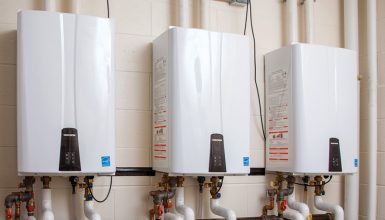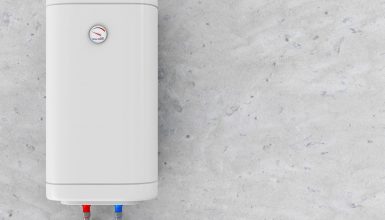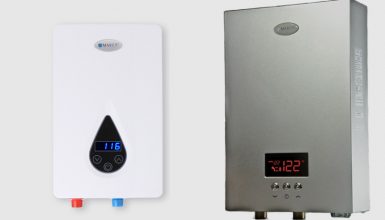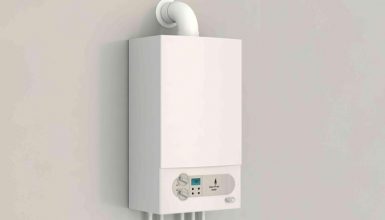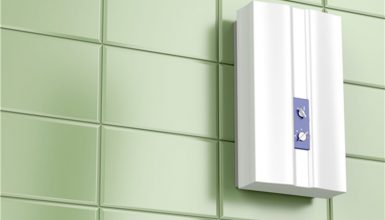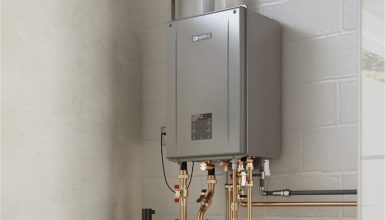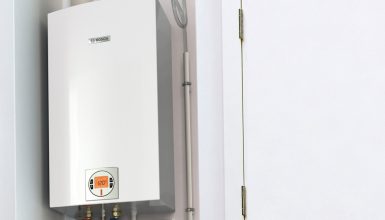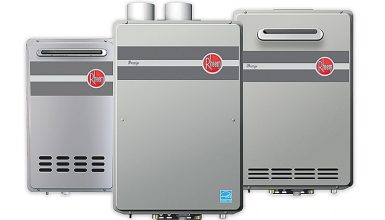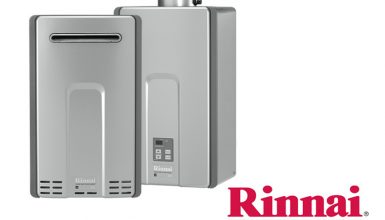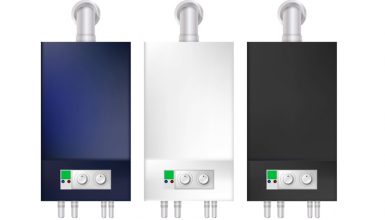Are you in the market for a tankless water heater? If you are, you’re probably familiar with the most popular and respected brand names. However, being familiar doesn’t mean that you have the information you need to make comparisons and decide which heater is best for you.
In this comparison review, we’ll do the match-ups for you. In other words, this is Rinnai vs. Navien vs. Rheem vs. Noritz vs. Takagi. We’ll explain each product, giving you the features, benefits, pros and cons, so you can decide which tankless water heater is best for you.
What to Look for in a Tankless Water Heater

Let’s start with a general overview. What features should you be looking for when you compare tankless water heaters. Here’s a quick run-down.
The first consideration is how much hot water you use. Since tankless water heaters don’t store heated water, you’ll need to consider your usage. That will help you determine if one tankless heater is sufficient for your needs or if you need more than one to ensure you don’t run out of hot water. Water use is measured in gallons per minute (GPM.)
Next, consider your home’s desired temperature rise. The temperature rise is the difference between the ground water temperature and the temperature you want your water to be heated to – usually 120 degrees Fahrenheit. If you live in a cold climate, it will require more energy to heat your water than it would if you live in a climate that’s warm year-round.
Tankless water heaters use either electricity or gas to heat water as it’s needed. You’ll want to consider your home’s energy sources, as well as the cost of electricity vs. gas, before you decide which tankless water heater to buy. Checking the unit’s energy efficiency rating can help, as well.
Price is always a consideration. Some heaters are more expensive than others and doing a cost comparison can help you stay within your budget, especially if you require more than one tankless water heater.
Rinnai vs. Navien vs Rheem vs. Noritz vs. Takagi Comparison Chart
Now that you know what to look for in a tankless water heater, let’s review the top five brands and compare them.








1. Rinnai RUC98iN

Our first product is the Rinnai RUC98iN. Let’s start by looking at its main features:
- 9.8 GPM flow and capacity
- Heats water using natural gas or propane
- Indoor installation only
- Energy Star certified
- Residential heating from 98 degrees F to 140 degrees F
- Commercial controller available (sold separately) for heating to 185 degrees F
- Unit weighs 82 pounds and measures 10” by 18.5” by 26”
Rinnai has a great reputation as a brand. Their heaters are high quality. This model comes with a 12-year warranty on heat exchangers, 5 years for parts, and a one-year labor warranty for home installations. After trying it out, we think this is a very reliable unit at a reasonable price.
Pros and Cons
The Rinnai RUC98iN has a lot of good qualities. Here’s what we like best about it:
- Heats water quickly and can handle high capacity
- Very quiet unit is barely noticeable even when you’re right next to it
- The included instructions are reasonably easy to follow
- Rinnai provides excellent customer service
Here are a few things we think could be better:
- Unless you have experience with plumbing and gas lines, you’ll need to pay for professional installation (although you may qualify for a tax break if you do)
- We noticed a slight decrease in water pressure when compared to a traditional storage tank
- Depending on the distance from the unit, you may have to wait up to a minute for the water to be hot
Overall, the Rinnai is a great product, especially for people who use a lot of hot water.
2. Navien NPE-240A
No products found.Now, let’s look at Navien vs. Rinnai. We’ve chosen the Navien NPE-240A as our next heater. Here are its primary features:
- 11.2 GPM flow and capacity
- Uses natural gas
- Wall-hanging model uses minimal space
- Energy Star certified
- Residential heating from 98 to 140 degrees Fahrenheit
- Unit weighs 82 pounds and measures 17.3” by 13.2” by 27.4 inches
What you can see from these specs is that this water heater has a slightly larger capacity than the Rinnai and, as you might expect, is slightly larger. Its heating capabilities are comparable. The Navien NPE-240A comes with a 15-year warranty.
Pros and Cons
Here are the pros of the Navien NPE-240A as we see them:
- 11.2 GPM ensures you’ll always have the hot water you need, when you need it
- There’s an insulated buffer tank to prevent the “cold water sandwich” effect that can result in a burst of cold water in the middle of a shower
- Can go as high as 160 degrees if you need very hot water
- High energy efficiency can save you money on your gas bill
There are a few things we think could be better. For example:
- This model is a bit louder than the Rinnai and is best installed away from bedrooms
- You can expect some condensation to build up when the heater is running
- It may take up to a minute for hot water to reach locations far from the heater
What we like most about this heater is its high GPM, which makes it an ideal choice for larger homes.
3. Rheem RTGH-95DVLN

Our next model is the Rheem RTGH-95DVLN. Let’s look at Rheem vs. Rinnai to get an idea of how this product measures up. Here are its primary features:
- 9.5 GPM flow and capacity
- Uses natural gas
- Intelligent electronic controls maximize energy efficiency
- Freeze protection to -30 degrees Fahrenheit
- Weighs 79 pounds and measures 18.5” by 9.8” by 27.5”
The company recommends using 3” PVC pipe to install, but that can be difficult to find. Fortunately, their directions offer the alternative of using ABS or galvanized steel. You may be able to use this unit with your existing gas line, but if you’re installing it yourself, call the gas company to confirm.
Pros and Cons
Now, let’s look at the pros and cons of the Rheem, starting with the pros as we see them:
- Turns on automatically when hot water usage gets to .4 GPM
- Once water is heated, it is virtually silent when in continual use
- Energy-efficient model may lower your gas bills significantly
There are a few potential cons to consider, as well:
- When it turns on, this unit is a bit on the noisy side – although as noted above, the noise is practically non-existent when it’s running continuously
- Self-installation may affect your warranty and hiring a professional can be expensive
- Maximum temperature is 120 degrees Fahrenheit, which may not be enough for people who like very hot showers and baths
The capacity of this model is not as high as the others we’ve reviewed so far, but for small homes this may the ideal choice.
4. Noritz NR981-SV-NG

Our next model is the Noritz NR981-NG. Let’s compare Noritz vs. Rinnai to see how it stacks up. Here are the Noritz’s primary features:
- 9.8 GPM capacity and flow
- Uses natural gas
- Lightweight model can hang on a 4” wall
- Energy Star certified
- Weighs 54 pounds and measures 17” by 13” by 29”
- Low Nox rating (a measurement of nitrous oxide emissions)
As you can see from the product specifications, the Noritz is by far the lightest tankless water heater we have reviewed so far. It’s weighs more than 20 pounds less than the next-lightest model, the Rheem. We also like that this model has a maximum temperature of 180 degrees, higher than any other tankless water heater in this review.
Pros and Cons
Here are the pros and cons of the Noritz 981 as we see them, starting with the pros:
- The Noritz can be used indoors or outdoors, which sets this model apart from the others we have reviewed
- Elevation adjustments make it possible to adjust the heater based on where you live, making it an ideal choice for those who live at high elevation
- Despite the fact that its capacity isn’t as high as the Naveen and the Rinnai, the high temperature limit ensures you’ll always have hot water
Here are a few potential cons to consider, as well:
- Installing the Noritz981 yourself may be problematic, so you’ll have to weigh professional installation costs against the pros
- It may take over a minute for hot water to get to your faucet or shower depending on where you place the heater
- May require minor plumbing modifications to work
The Noritz981 is not inexpensive, but we think the indoor/outdoor placement and elevation adjustments are what set it apart from its competitors.
5. Takagi T-KJr2-IN-LP

Now, let’s look at our final model, the Takagi T-KJr2. Comparing Takagi vs. Rinnai can help us evaluate this product. Here are its main features:
- 6.6 GPM capacity and flow
- Maximum heat of 167 degrees Fahrenheit
- Uses natural gas
- Requires a dedicated outlet to use
- Energy Star certified
- Weighs 38 pounds and measures 6.7” by 13.8” by 20.3”
As you can see from the above specifications, this is a small and very lightweight unit. It’s not ideal for large homes (unless you plan on buying several units to handle your hot water needs.) However, for small homes or those with limited hot water needs, this is an inexpensive model with a lot to offer.
Pros and Cons
There are pros and cons to buying the Takagi vs the other products we’ve reviewed here. Let’s look at them, starting with the pros as we see them:
- The affordable price makes this model the ideal choice for small homes with limited hot water usage
- Remote temperature control allows you to adjust the temperature easily
- Starts working with minimal flow and delivers hot water quickly as needed
Here are a few potential cons to consider:
- If your house uses well water, you’ll need a filtration system to avoid clogging up the Takagi when it’s running
- Setting the switch to propane invalidates the warranty, so be careful to set it to natural gas
- This machine is a bit on the loud side, so you may want to insulate it or place it somewhere away from bedrooms or offices
Because this unit is a small one, we think it’s ideal for small homes or people who live alone. We do think that it’s worthwhile hiring a pro to install it. We noticed that this unit came with the switch set to propane, so make sure to double check that before you hook it up.
Conclusion
How do you decide which tankless water heater to buy for your home? We recommend starting with capacity. It may be helpful to look up the GPM for your faucets, showers, and appliances that use water. That will help you determine how much hot water you’ll need so you can compare capacity.
After that, you’ll want to consider the other specifications and features of Rinnai vs. Navien vs. Rheem vs. Noritz vs. Takagi. Each one of these heaters has pros and cons. We’d be inclined to go for a model that is Energy Star certified since one of the primary reasons to switch to a tankless water heater is to save money on your energy bills.
Noise is another thing to keep in mind. The Takagi and Rheem were the two noisiest models – but that may not be a factor if you can install them away from bedrooms and quiet areas. If you live at elevation, you may prefer the Noritz, which is the only model that allows you to adjust for that.
Ultimately, the best tankless water heater is the one that will ensure you have the hot water you need when you need it. Any one of these five models might be the hot water solution you’ve been looking for.

